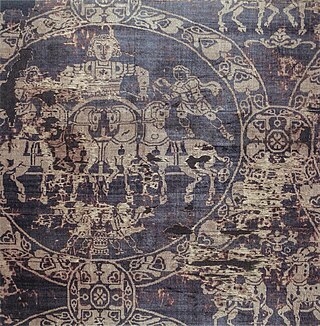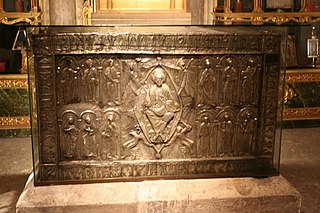
Linen is a textile made from the fibers of the flax plant.
A number of alleged relics associated with Jesus have been displayed throughout the history of Christianity. While some individuals believe in the authenticity of Jesus relics, others doubt their validity. For instance, the sixteenth-century philosopher Erasmus wrote about the proliferation of relics, and the number of buildings that could be constructed from wooden relics claimed to be from the crucifixion cross of Jesus. Similarly, at least thirty Holy Nails were venerated as relics across Europe in the early 20th century. Part of the relics are included in the so-called Arma Christi, or the Instruments of the Passion.

Shroud usually refers to an item, such as a cloth, that covers or protects some other object. The term is most often used in reference to burial sheets, mound shroud, grave clothes, winding-cloths or winding-sheets, such as the famous Shroud of Turin, tachrichim that Jews are dressed in for burial, or the white cotton kaffan sheets Muslims are wrapped in for burial.

According to Christian tradition, the Image of Edessa was a holy relic consisting of a square or rectangle of cloth upon which a miraculous image of the face of Jesus had been imprinted—the first icon. The image is also known as the Mandylion, in Eastern Orthodoxy, it is also known as Acheiropoieton.
Walter Cox McCrone Jr. was an American chemist who worked extensively on applications of polarized light microscopy and is sometimes characterized as the "father of modern microscopy". He was also an expert in electron microscopy, crystallography, ultra-microanalysis, and particle identification. In 1960 he founded the McCrone Research Institute, a non-profit educational and research organization for microscopy based in Chicago.
Ian Wilson is a British prolific author of historical and religious books. He has investigated such topics as the Shroud of Turin and life after death.

The Shroud of Turin, also known as the Holy Shroud, is a length of linen cloth that bears a faint image of the front and back of a man. It has been venerated for centuries, especially by members of the Catholic Church, as the actual burial shroud used to wrap the body of Jesus of Nazareth after his crucifixion, and upon which Jesus's bodily image is miraculously imprinted. The human image on the shroud can be discerned more clearly in a black and white photographic negative than in its natural sepia color, an effect discovered in 1898 by Secondo Pia, who produced the first photographs of the shroud. This negative image is associated with a popular Catholic devotion to the Holy Face of Jesus.

John 20:7 is the seventh verse of the twentieth chapter of the Gospel of John in the Bible. In this verse, Peter is standing in Jesus' empty tomb. The Beloved Disciple and perhaps Mary Magdalene are outside. This verse describes the arrangement of the grave clothes they see.

An altar cloth is used in the Christian liturgy to cover the altar. It serves as a sign of reverence as well as a decoration and a protection of the altar and the sacred vessels. In the orthodox churches it is covered by the antimension, which also contains the relics of saints.

Luke 24 is the twenty-fourth and final chapter of the Gospel of Luke in the New Testament of the Christian Bible. The book containing this chapter is anonymous, but early Christian tradition uniformly affirmed that Luke the Evangelist composed this Gospel as well as the Acts of the Apostles. This chapter records the discovery of the resurrection of Jesus Christ, his appearances to his disciples and his ascension into heaven.

Matthew 27:59 is the fifty-ninth verse of the twenty-seventh chapter of the Gospel of Matthew in the New Testament. This verse describes Joseph of Arimathea gathering Jesus' body after the crucifixion.
Robert de Clari was a knight from Picardy. He participated in the Fourth Crusade with his lord, Count Peter of Amiens, and his brother, Aleaumes, and left a chronicle of the events in Old Picard, De la Conquête de Constantinople. Robert's account of the crusade is especially valuable because of his status as a lower vassal; most other eyewitness accounts are from the leadership of the crusade, like Villehardouin. Robert's descriptions often shed light on some of the crusader activities that are otherwise glossed over by the higher rank sources.

The Shroud of Turin, a linen cloth that tradition associates with the crucifixion and burial of Jesus, has undergone numerous scientific tests, the most notable of which is radiocarbon dating, in an attempt to determine the relic's authenticity. In 1988, scientists at three separate laboratories dated samples from the Shroud to a range of 1260–1390 CE, which coincides with the first certain appearance of the shroud in the 1350s and is much later than the burial of Jesus in 30 or 33 CE. Aspects of the 1988 test continue to be debated. Despite some technical concerns that have been raised about radiocarbon dating of the Shroud, no radiocarbon-dating expert has asserted that the dating is substantially unreliable.

Herringbone, also called broken twill weave, describes a distinctive V-shaped weaving pattern usually found in twill fabric. It is distinguished from a plain chevron by the break at reversal, which makes it resemble a broken zigzag. The pattern is called herringbone because it resembles the skeleton of a herring fish. Herringbone-patterned fabric is usually wool, and is one of the most popular cloths used for suits and outerwear. Tweed cloth is often woven with a herringbone pattern.

During its history, the Shroud of Turin has been subjected to repairs and restoration, such as after the fire which damaged it in 1532. Since 1578 the Shroud has been kept in the Royal Chapel of Turin Cathedral. Currently it is stored under the laminated bulletproof glass of an airtight case, filled with chemically-neutral gasses. The temperature and humidity controlled-case is filled with argon (99.5%) and oxygen (0.5%) to prevent chemical changes. The Shroud itself is kept on an aluminum support sliding on runners and stored flat within the case.

The History of the Shroud of Turin begins in the year 1390 AD, when Bishop Pierre d'Arcis wrote a memorandum where he charged that the Shroud was a forgery. Historical records seem to indicate that a shroud bearing an image of a crucified man existed in the possession of Geoffroy de Charny in the small town of Lirey, France around the years 1353 to 1357. The history from the 15th century to the present is well documented.

The Manoppello Image is a piece of linen cloth depicting the face of Jesus Christ that is stored in a church in the village of Manoppello, Italy. The church, known as Santuario del Volto Santo, is part of a monastery belonging to Capuchin friars. There have been claims that the cloth is the Veil of Veronica.

The Shroud of Turin is a length of linen cloth bearing the imprint of the image of a man, and is believed by some to be the burial shroud of Jesus. Despite conclusive scientific evidence from three radiocarbon dating tests performed in 1988 which resulted in the shroud being dated to 1260–1390 AD, some researchers have challenged the dating based on various theories, including the provenance of the samples used for testing, biological or chemical contamination, incorrect assessment of carbon dating data, as well as other theories. However, the alternative theories challenging the radiocarbon dating have been disproved by scientists using actual shroud material, and are thus considered to be fringe theories.











